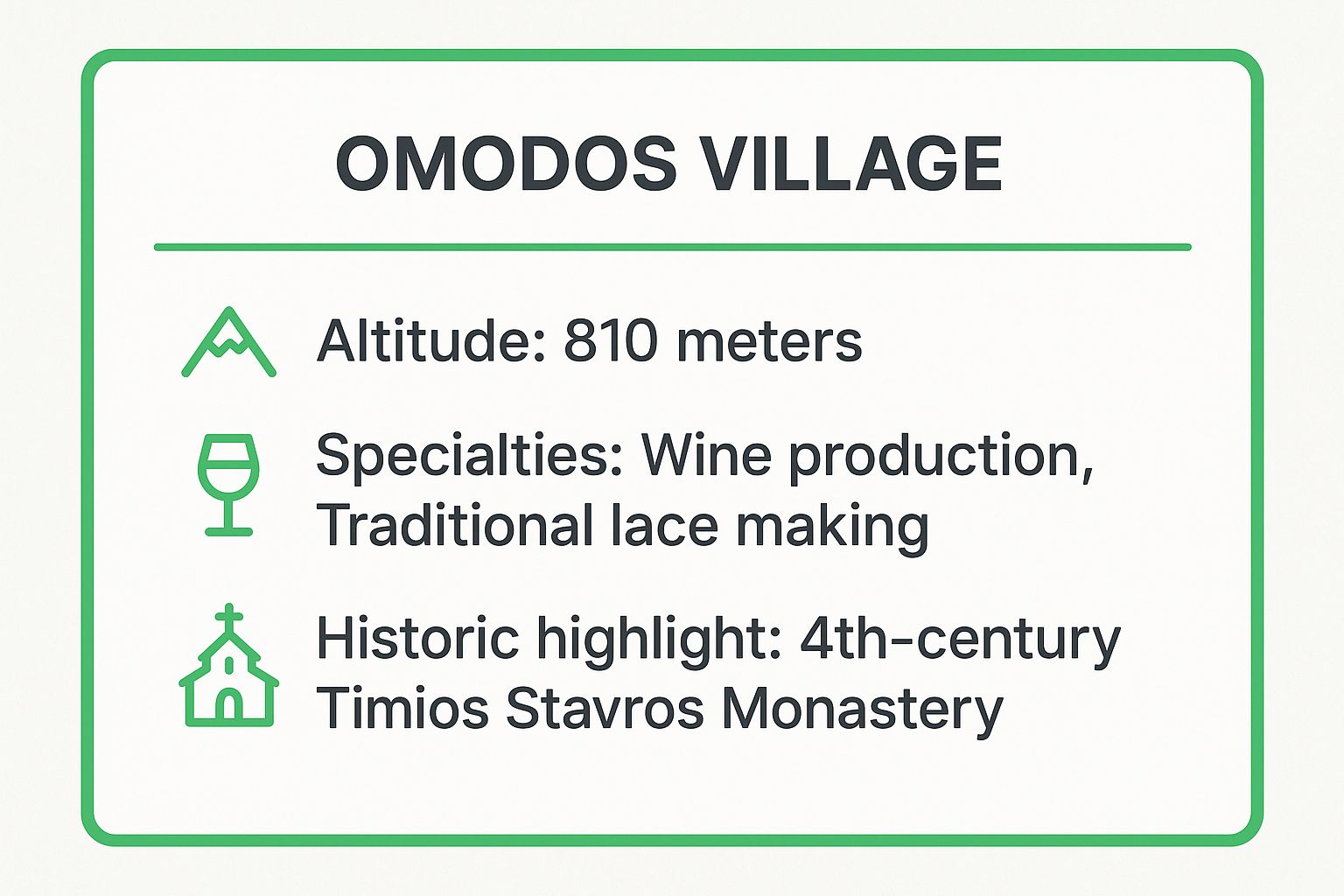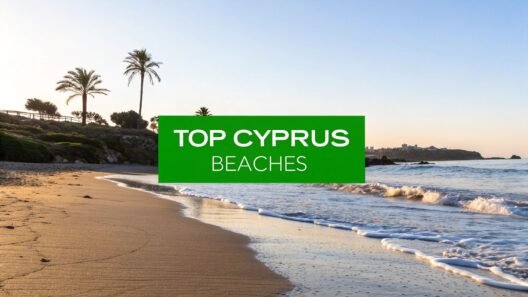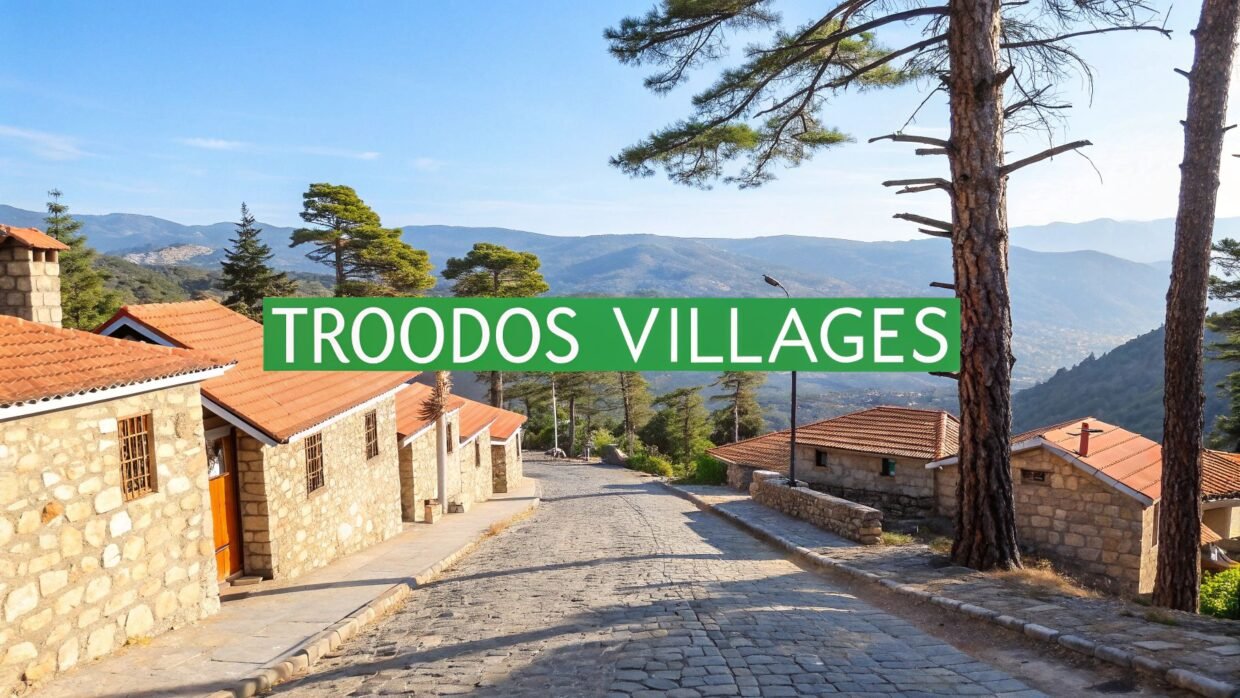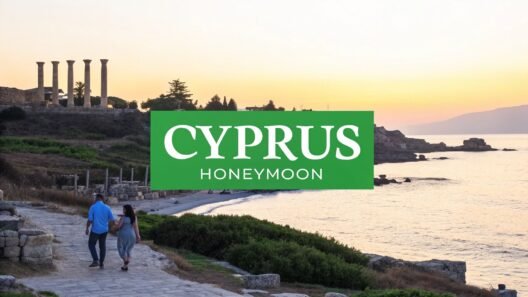Beyond the Coast: Discovering the Heart of Cyprus in its Mountain Villages
While Cyprus is celebrated for its sun-drenched coastline, the island's true soul lies nestled in the cool, pine-scented air of its central mountain range. The Troodos Mountains villages offer a journey back in time, where cobblestone streets wind past stone-built houses with terracotta roofs, and ancient traditions are a part of daily life. This guide is your definitive roadmap to exploring the most enchanting of these mountain settlements, moving beyond the typical tourist trails to reveal the authentic core of Cypriot culture.
We'll provide a detailed look into must-visit locations like the famed wine-making hub of Omodos and the historically preserved old quarter of Kakopetria. You will discover practical travel insights for each destination, from locating the best local tavernas in Lofou to understanding the unique craft traditions of Lefkara. Forget the crowded beaches for a moment; this curated list will equip you with everything needed to explore the breathtaking beauty of Cyprus's mountainous heartland. Prepare for an unforgettable experience that showcases a different, more profound side of this magnificent island.
1. Omodos Village
Nestled in the heart of the Krasochoria, or "wine villages," Omodos stands as one of the most celebrated and picturesque Troodos Mountains villages. Situated at an altitude of 810 metres, this village has masterfully preserved its traditional character, from its stone-built houses with terracotta roofs to its labyrinthine, cobblestone lanes. Omodos is not merely a scenic stop; it is a living museum of Cypriot rural life, renowned for its deep-rooted winemaking heritage and vibrant local crafts.
The village square is the bustling centrepiece, dominated by the historic and majestic Timios Stavros Monastery (Monastery of the Holy Cross). This site, with origins tracing back to the 4th century, houses what is believed to be a piece of the Holy Cross and the Holy Rope, making it a significant pilgrimage destination. Beyond its religious importance, the monastery’s intricate architecture and accompanying museums offer a deep dive into the region's ecclesiastical art and history. Omodos serves as a prime example of successful heritage tourism, transforming from a quiet agricultural community into a thriving hub that celebrates its authentic identity, drawing visitors year-round to its annual wine festival and charming atmosphere.
Key Highlights and Insider Tips
For a quick overview, this summary box highlights the essential features of Omodos Village.

These key features underscore why Omodos is a multifaceted destination, blending high-altitude scenery with profound history and specialised local crafts.
To make the most of your visit, consider these actionable tips:
- Time Your Visit: Omodos is a popular destination, especially on weekends and public holidays. To experience its tranquil charm without the crowds, plan your trip for a weekday morning.
- Savour Local Flavours: No visit is complete without sampling the local wine. Stop by a traditional taverna for a glass of Xynisteri or Maratheftiko, or visit a family-run winery for a guided tasting. Also, try the local arkatena (crunchy rusks with chickpea yeast).
- Explore Beyond the Square: While the main square and monastery are captivating, the real magic lies in the narrow side streets. Wander off the main path to discover hidden courtyards, artisan workshops, and authentic scenes of village life. If you're looking to seamlessly integrate this village into a broader travel plan, you can find more information about creating a comprehensive Cyprus travel itinerary here.
- Purchase Authentic Crafts: Omodos is famous for its handmade lace (pipila) and intricate silverware. Purchase directly from the artisans who often sit outside their shops, ensuring you get a genuine, high-quality souvenir while supporting the local economy.
2. Platres Village
Often hailed as the king of Cypriot mountain resorts, Platres holds a distinguished place among the Troodos Mountains villages. Divided into Pano Platres (Upper Platres) and Kato Platres (Lower Platres) and sitting at a refreshing altitude of 1,200 metres, it has been a sought-after escape since the British colonial era. Its cool, pine-scented air offered a welcome respite from the summer heat of the lowlands, establishing it as a premier destination for aristocrats and officials. Today, Platres balances its historic grandeur with modern amenities, offering a sophisticated base for exploring the surrounding natural wonders.

The village’s enduring appeal lies in its successful development as a mountain tourism hub, a legacy visible in its grand, early 20th-century hotels and colonial-style villas. Unlike more rustic villages, Platres exudes an air of timeless elegance, blending luxury with nature. It serves as a perfect model of sustainable resort development, attracting visitors who come for its hiking trails, proximity to Caledonia and Millomeris waterfalls, and the sheer tranquillity of its forested landscape. The combination of historical significance and natural beauty makes it an essential stop on any Troodos itinerary.
Key Highlights and Insider Tips
For a quick overview, this summary box highlights the essential features of Platres Village. It has long been popularised by British colonial administrators and luxury hotel developers, solidifying its status as a high-end mountain retreat.
These key features underscore why Platres is a multifaceted destination, blending high-altitude scenery with profound history and specialised local crafts.
To make the most of your visit, consider these actionable tips:
- Book Well in Advance: Platres is extremely popular during the peak summer months (July-August) and winter ski season. To secure accommodation, especially in the more historic hotels, it is crucial to book several months ahead.
- Use as a Hiking Base: The village is the gateway to some of Cyprus's best nature trails. Use it as your starting point for a hike to the Caledonia or Millomeris waterfalls. The trails are well-marked and offer stunning forest scenery.
- Explore Both Platres: Don't just stay in Pano Platres, the main tourist hub. Take a walk or a short drive down to Kato Platres to experience a quieter, more traditional side of the community with its own distinct charm.
- Travel in Shoulder Seasons: For fewer crowds and better rates on accommodation, plan your visit for late spring (May-June) or early autumn (September-October). The weather is still pleasant for outdoor activities, and the village is more peaceful. For those seeking a truly relaxing escape, Platres is also home to some of the finest spa hotels in Cyprus.
3. Kakopetria Village
Split into two distinct parts by the gentle flow of the Karyotis River, Kakopetria is a standout gem among the Troodos Mountains villages. Located in the Solea Valley at an altitude of 667 metres, its name translates to "Bad Stone," a nod to local legend. The village is celebrated for its meticulously preserved old quarter, Palia Kakopetria, which stands as a protected national monument of Cypriot heritage architecture. Its overhanging wooden balconies, narrow stone-paved streets, and restored houses create a timeless atmosphere that feels like stepping into a bygone era.

The modern part of the village, with its shops, restaurants, and hotels, sits above the old town, but it is the historic core that captures the imagination. Palia Kakopetria’s architectural integrity has made it a model for heritage conservation in Cyprus and a popular backdrop for period films. The village successfully balances its role as a living community with being a major tourist destination, offering a perfect blend of natural beauty, profound history, and authentic mountain hospitality. The constant sound of the river provides a soothing soundtrack to any visit, enhancing its unique, tranquil charm.
Key Highlights and Insider Tips
For a quick overview, this summary box highlights the essential features of Kakopetria Village.
These key features underscore why Kakopetria is a must-visit, combining picturesque architecture with natural beauty and historical significance.
To make the most of your visit, consider these actionable tips:
- Walk the Old Quarter Early: To capture the best photographs and experience the magic of Palia Kakopetria without the crowds, plan a walk through its narrow lanes early in the morning. The soft light and quiet atmosphere are truly enchanting.
- Discover a UNESCO Gem: Take a short drive to the nearby Agios Nikolaos tis Stegis (St. Nicholas of the Roof) church. This 11th-century Byzantine monastery is a UNESCO World Heritage site, renowned for its stunning, well-preserved frescoes spanning over 600 years.
- Enjoy a Riverside Meal: Many of the village's tavernas are situated along the river. Book a table at one to enjoy fresh, locally-farmed trout while listening to the calming sounds of the water. It’s a quintessential Kakopetria experience.
- Stay in a Traditional Guesthouse: For a fully immersive experience, consider staying overnight in one of the restored stone houses in the old quarter. This offers a unique opportunity to appreciate the traditional architecture from the inside and enjoy the village after the day-trippers have left.
4. Lefkara Village
Renowned globally for its intricate lacework and exquisite silver handicrafts, Lefkara is arguably one of the most famous Troodos Mountains villages. It is divided into Pano (Upper) and Kato (Lower) Lefkara, with Pano Lefkara being the larger and more visited centre of activity. Perched on the southern slopes of the mountains, the village boasts a heritage so significant that its traditional lace, known as Lefkaritika, is recognised on the UNESCO Intangible Cultural Heritage List. Its stone-paved streets and beautifully preserved houses with distinctive architecture create an atmosphere of timeless elegance.
Lefkara’s legacy is woven with legendary tales, including a widely told story that Leonardo da Vinci visited in 1481 and purchased a piece of local lace for the main altar of the Duomo di Milano. This international recognition has cemented Lefkara's status not just as a picturesque destination, but as a vital hub for preserving traditional Cypriot arts. It stands as a remarkable example of how a community has successfully sustained its artisan industries for centuries, transforming its cultural heritage into a living, breathing economy that captivates visitors from around the world.
Key Highlights and Insider Tips
For a quick overview, this summary box highlights the essential features of Lefkara Village.
These key features underscore why Lefkara is a unique destination, blending world-renowned craftsmanship with stunning traditional architecture.
To make the most of your visit, consider these actionable tips:
- Watch Artisans in Action: The heart of Lefkara's charm is its craftspeople. Wander through the village to see women sitting in their doorways, meticulously creating Lefkaritika lace, a tradition passed down through generations. Many silversmiths also have open workshops where you can watch them craft delicate filigree jewellery.
- Purchase Authentic Souvenirs: When buying lace or silver, purchase directly from the workshops or reputable local shops to ensure you are getting an authentic, handmade item. Ask about the patterns and techniques; the artisans are often happy to share the stories behind their work.
- Explore Both Villages: While Pano Lefkara is the main attraction, take a short walk or drive down to Kato Lefkara. It offers a quieter, more rustic glimpse into local life, with its own beautiful architecture and peaceful ambiance.
- Visit the Museums: To fully appreciate the village's heritage, visit the Lefkara Handicraft Centre and the Museum of Traditional Embroidery and Silversmithing. These institutions provide a fascinating insight into the history and evolution of the local crafts. After exploring, you might want to find out about the top-rated restaurants in Cyprus to complete your day.
5. Galata Village
Situated in the verdant Solea Valley, Galata is one of the most authentically preserved Troodos Mountains villages, offering a quieter, more agricultural atmosphere than its more tourist-focused neighbours. Built along the banks of the Karkotis River, the village is characterised by its traditional stone houses with wooden balconies, steep terraced hillsides, and the lingering scent of fruit orchards. Galata has successfully maintained its role as a working agricultural community, primarily known for its delicious apples, peaches, and grapes, while also serving as a gateway to some of Cyprus's most significant cultural treasures.
The village itself is split into two halves, with traditional architecture dominating the older upper section. However, Galata’s primary draw lies in its proximity to several UNESCO-listed painted churches. Just a short distance away, these Byzantine marvels, including the famous Panagia tis Podithou and Archangelos Michael, feature breathtaking frescoes that have survived for centuries. This unique blend of living agricultural heritage and profound religious history makes Galata a compelling destination for those seeking to experience a deeper, more traditional side of Cypriot mountain life, away from the bustling crowds.
Key Highlights and Insider Tips
For a quick overview, this summary box highlights the essential features of Galata Village. These features underscore how Galata provides an experience that is both deeply cultural and authentically rural.
To make the most of your visit, consider these actionable tips:
- Arrange Church Visits in Advance: The UNESCO-listed churches are the main attraction. As they are often kept locked for preservation, it's wise to contact the local priest or a designated keyholder beforehand to arrange access. This simple step ensures you don't miss out on the incredible interior frescoes.
- Taste the Local Produce: Galata’s economy is built on agriculture. Visit a local grocer or stall to buy fresh, seasonal fruit directly from the producers. In autumn, the apples are particularly renowned for their crispness and flavour.
- Explore Both Sides of the River: Galata is connected to its sister village, Kakopetria, by a walking path along the Karkotis River. Take a leisurely stroll between the two to appreciate the contrasting atmospheres while enjoying the serene natural surroundings.
- Respect the Working Community: Remember that Galata is a living, working village, not just a tourist site. Be mindful of private properties, active orchards, and the daily routines of residents to ensure your visit is respectful and unobtrusive.
6. Pedoulas Village
Perched at an altitude of 1,100 metres in the Marathasa Valley, Pedoulas is one of the most historically significant Troodos Mountains villages. Famous for its sweet cherries and rich religious heritage, the village is built amphitheatrically on the mountainside, offering stunning panoramic views. Pedoulas seamlessly blends its agricultural roots with its role as a guardian of profound Byzantine history, making it a captivating destination for those interested in both culture and nature.
The village's international claim to fame is the Archangelos Michael church, a UNESCO World Heritage site dating back to 1474. This small, timber-roofed chapel contains some of the best-preserved frescoes of the post-Byzantine period in Cyprus. Pedoulas also holds modern historical importance as the birthplace of Archbishop Makarios III, the first President of the Republic of Cyprus. The village successfully balances its quiet, rural charm with its status as a site of national and global significance, offering a layered experience that rewards curious visitors.
Key Highlights and Insider Tips
This summary provides a quick look at the essential features of Pedoulas Village.
These key features illustrate how Pedoulas offers a unique mix of high-altitude agriculture, pivotal religious art, and important modern history.
To ensure you get the most from your visit, here are some actionable tips:
- See the UNESCO Frescoes: The Church of Archangelos Michael is the main draw. It is often kept locked, so plan to ask locals for the keyholder's location, usually found at a nearby house or coffee shop. This small effort is essential to witness the vibrant 15th-century artwork inside.
- Visit During Cherry Season: Plan your trip for late spring (May to June) to see the cherry orchards in full bloom or during the harvest. The annual Cherry Festival celebrates this local treasure with fresh fruit, traditional products, and festivities.
- Explore Makarios's Roots: Visit the Byzantine Museum of Pedoulas and the small museum dedicated to Archbishop Makarios III. These sites offer context to the village’s role in Cyprus's religious and political history, providing a deeper understanding of its local hero.
- Combine with a Church Tour: Pedoulas is an ideal starting point for exploring other painted churches in the Troodos region. Use it as a base to visit nearby UNESCO sites like Panagia tou Moutoulla and Agios Ioannis Lampadistis Monastery in Kalopanagiotis.
7. Lofou Village
Perched on a hill overlooking the Kouris river valley, Lofou is a remarkable testament to revival and a standout among the Troodos Mountains villages. Once a thriving agricultural hub, the village faced near-total abandonment by the mid-20th century. However, a concerted effort involving former residents, private investment, and EU funding has transformed it into a stunningly restored showcase of traditional Cypriot architecture. Lofou now serves as a model for sustainable heritage tourism, offering an authentic, tranquil escape without sacrificing its historical integrity.
The village’s name, derived from the Greek word lofos (hill), perfectly describes its setting. Its tightly clustered, stone-built houses and winding, cobbled pathways are meticulously preserved, creating an atmosphere that feels frozen in time. Unlike more bustling villages, Lofou’s charm lies in its quiet elegance and the palpable sense of history that permeates its every corner. It demonstrates how a community can honour its past while creating a viable future, making it a compelling destination for those interested in cultural preservation and architectural beauty.
Key Highlights and Insider Tips
For a quick overview, this summary box highlights the essential features of Lofou Village.
The village’s primary draw is its architectural purity and serene environment, offering a unique blend of historical immersion and modern comfort.
To make the most of your visit, consider these actionable tips:
- Book Heritage Accommodation: To fully absorb Lofou’s unique atmosphere, stay in one of the beautifully restored traditional houses. These accommodations combine rustic charm with modern luxuries, offering an immersive experience of village life.
- Explore the Olive Press Museum: Visit the old olive press, which has been converted into a small museum. It provides fascinating insight into the village's agricultural past and the traditional methods of olive oil production that once sustained the community.
- Dine with a View: Several tavernas in Lofou offer panoramic views over the surrounding hills. Enjoy a meal of authentic Cypriot cuisine on a terrace as the sun sets, providing a truly memorable dining experience.
- Follow the Nature Trail: A designated trail begins at the village and winds through the scenic countryside. It’s a great way to appreciate the area's natural beauty and see the historic Foinikas water fountain, a vital source of water in centuries past.
Troodos Villages Comparison Guide
| Village | Implementation Complexity 🔄 | Resource Requirements ⚡ | Expected Outcomes 📊 | Ideal Use Cases 💡 | Key Advantages ⭐ |
|---|---|---|---|---|---|
| Omodos Village | Moderate – maintaining traditional heritage with tourism | Moderate – local artisans, tourist services | Thriving heritage tourism, cultural preservation | Cultural tourism, wine festivals, day trips | Rich heritage, strong wine industry, accessibility |
| Platres Village | High – luxury resorts and well-developed infrastructure | High – hotels, spas, trail maintenance | Established mountain resort, outdoor activity hub | Wellness retreats, hiking base, summer escape | Luxury facilities, cool climate, natural attractions |
| Kakopetria Village | Moderate – conservation of traditional architecture | Low to moderate – guesthouses, minimal services | Authentic village tourism with heritage focus | Heritage tourism, quiet stays, nature walks | Authentic atmosphere, scenic river setting |
| Lefkara Village | Moderate – preservation of crafts and artisan workshops | Moderate – artisan community support | Sustained traditional crafts, UNESCO recognition | Craft tourism, heritage exploration | UNESCO status, active artisan economy |
| Galata Village | Low to moderate – balancing agriculture with tourism | Low – traditional farming and basic tourism | Preservation of agricultural heritage and culture | Cultural/religious tourism, authentic village | Access to Byzantine churches, authentic farming community |
| Pedoulas Village | Moderate – heritage site conservation with village life | Low to moderate – heritage site management | Religious tourism, historical significance | Religious tourism, history enthusiasts | UNESCO church, historic birthplace |
| Lofou Village | High – full restoration and luxury tourism development | High – restoration funding, luxury facilities | Sustainable tourism model, heritage conservation | Luxury rural tourism, sustainable development | Exemplary restoration, luxury accommodations |
Your Mountain Adventure Awaits
The Troodos Mountains are not merely a geographical feature of Cyprus; they are the island's vibrant, beating heart. As we have journeyed through this guide, from the cobbled, wine-rich lanes of Omodos to the restored, peaceful allure of Lofou, it becomes clear that the Troodos mountains villages are far more than picturesque destinations. They are living, breathing archives of Cypriot heritage, resilience, and time-honoured traditions. Each village, with its unique character, offers a distinct narrative: Platres whispers tales of a glamorous past, Kakopetria showcases medieval architecture frozen in time, and Lefkara presents its world-renowned lace and silverwork with quiet pride.
Choosing to venture beyond the sun-drenched coastline and into these cooler, pine-scented altitudes is to choose a more profound connection with Cyprus. It is an opportunity to slow down, to engage with local artisans, to savour flavours that have been perfected over generations, and to witness a way of life that remains deeply connected to the natural rhythms of the seasons. The value of this experience extends beyond beautiful holiday photos; it fosters a genuine appreciation for the cultural fabric that makes Cyprus so endlessly fascinating.
Planning Your Troodos Itinerary: Key Takeaways
To make the most of your mountain exploration, remember these crucial insights from our guide:
- Plan Strategically: While the villages appear close on a map, the winding mountain roads can make travel times longer than expected. Group your visits by region, perhaps focusing on the Pitsilia area (Platres, Pedoulas) one day and the Solea Valley (Kakopetria, Galata) another.
- Embrace 'Siga-Siga': The Cypriot concept of 'slowly, slowly' is the unofficial motto here. Don't rush. Allow yourself time to wander aimlessly, to sit at a traditional kafenio (coffee shop), and to absorb the tranquil atmosphere. The best discoveries are often unplanned.
- Look Beyond the Obvious: Every village has its famous church or landmark, but the real magic lies in the details. Notice the intricately carved wooden balconies in Kakopetria, seek out the smaller, family-run wineries in Omodos, and find the workshops where Lefkaritika lace is still meticulously crafted by hand.
Your Next Steps to an Unforgettable Trip
Your adventure into the Troodos mountains villages is now within reach. The next step is to translate inspiration into action. Begin by sketching out a loose itinerary based on the villages that resonated most with you. Do you crave the artistic legacy of Lefkara, the forest trails around Platres, or the historical depth of Galata’s painted churches?
Consider the season of your visit, as each offers a different experience, from snow-dusted peaks in winter to lush, green valleys in spring. Booking accommodation directly within one of these villages, even for a night or two, will provide a truly immersive experience, allowing you to witness the peaceful evening calm after the day-trippers have departed. Ultimately, exploring these mountain gems offers a refreshing, authentic counterpoint to the coastal resorts, revealing the true soul of Cyprus.
Ready to build your perfect Cypriot itinerary? For bespoke travel planning, exclusive local insights, and curated experiences that go beyond the guidebook, visit SayCyprus. We specialise in helping travellers discover the authentic charm of Cyprus, including the hidden treasures of the Troodos Mountains.












